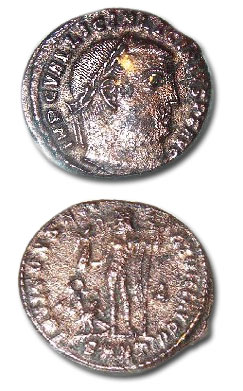A Journey Through Time and History
Roman coins, relics of an ancient empire, offer a fascinating glimpse into a bygone era. However, the passage of time and the elements often leave these coins tarnished and obscured. Embarking on the journey to clean Roman coins is akin to unlocking the secrets of history, revealing the stories etched upon their surfaces.

Image: www.nerocoins.com
Before delving into the art of numismatic preservation, let us venture into the world of ancient Rome. Coined currency emerged in this bustling empire around the 4th century BC, marking a pivotal moment in its economic and political landscape. These coins bore the likenesses of emperors, gods, and symbols of Roman power, serving as symbols of identity and wealth.
Unlocking the Mysteries: A Step-by-Step Guide
Approaching the task of cleaning Roman coins requires a delicate balance between removing tarnish and preserving the coin’s integrity. Embrace the following steps as your guide to unlocking their ancient beauty:
- Initial Examination: Begin by carefully examining the coin under proper lighting. Determine the extent and nature of the tarnish or dirt.
- Soft Cleaning: For light dirt or patina, a soft brush or cloth can gently dislodge surface impurities. Avoid using abrasive materials that could damage the coin’s surface.
- Olive Oil Immersion: Immerse the coin in pure olive oil for several hours or overnight. This technique loosens tarnish and dirt, allowing for easier removal.
- Mechanical Removal: Use a wooden or plastic toothpick to gently scrape away loosened tarnish. Avoid using metal tools to prevent scratching the coin’s surface.
- Baking Soda Paste: Create a paste of baking soda and water. Apply it to the coin and let it sit for 30 minutes before rinsing with distilled water.
- Electrolysis: For severely tarnished coins, electrolysis can be employed as a more advanced method. However, it should only be performed by experienced professionals.
Remember, patience and caution are paramount during the cleaning process. Always test the technique on an inconspicuous area of the coin first to ensure it does not cause damage.
Seeking Expert Guidance: Tips and Advice
Enrich your numismatic endeavors by embracing the insights of seasoned collectors and experts:
- Preserve Original Patina: The natural patina that forms on Roman coins over time imparts character and historical value. While cleaning enhances legibility, try to preserve the patina whenever possible.
- Avoid Harsh Chemicals: Never use harsh chemicals like bleach or ammonia to clean Roman coins, as they can irreparably damage the metal.
- Seek Professional Help: For coins with intricate details or severe corrosion, consider seeking the assistance of a professional numismatist.
Common Questions and Concise Answers
- Q: What is the best way to remove heavy corrosion?
A: Severe corrosion is best addressed by a professional numismatist using specialized techniques. - Q: Can all Roman coins be cleaned?
A: Not all Roman coins should be cleaned. Consult a numismatist to determine whether cleaning is advisable. - Q: How can I prevent future tarnishing?
A: Store cleaned coins in a dry, climate-controlled environment to minimize exposure to moisture and pollutants.

Image: gometaldetecting.com
How To Clean Roman Coins
Epilogue: A Call to Curiosity and Enlightenment
Restoring the splendor of Roman coins is a testament to the enduring fascination with history and human ingenuity. In this pursuit, embrace the principles of preservation and knowledge, and never cease to marvel at the stories that lie hidden within these ancient artifacts.
Is the allure of timeless relics calling out to you? Explore the captivating world of Roman coins further by delving into its rich history, intricacies, and significance. Unearth the secrets of the past and witness the enduring legacy of one of history’s most influential empires.